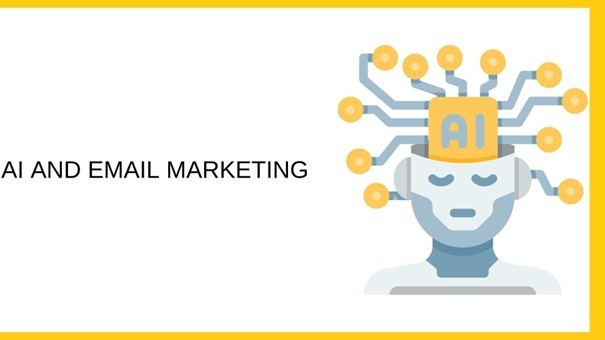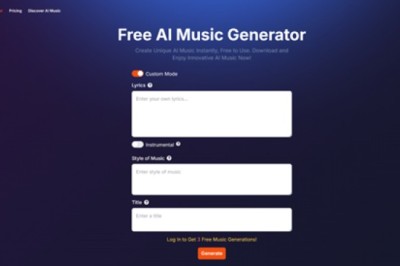views

AI and email marketing have an interesting relationship because AI is quietly revolutionizing each layer of digital marketing, giving companies the power to automate, analyze, and optimize their practices with a level of accuracy that was unimaginable only a few years ago. And while social media and paid ads get most of the buzz, email marketing has remained a reliable, measurable, and rather personal way to stay in touch with your potential and existing customers. You can share your important updates, run special promotions, or say hello without the headache of being buried by ever-changing algorithms on social networks.
I've seen in my own small startups how email campaigns keep driving stable engagement-even when other channels get a bit overcrowded. I remember when I first introduced AI into our process of email marketing; I was excited and, at the same time, a bit overwhelmed by all the new possibilities. Soon enough, though, we could see that AI transformed our sends into more specialized, efficient, and better-converting campaigns than we'd ever had before.
Benefits of AI-Driven Personalization
I used to send broad email blasts, thinking one message could suit everyone. Turns out, that approach is a bit outdated. One of the biggest revelations for me—and probably for many marketers—has been discovering how AI refines personalization and segmentation based on real-time data and user preferences.
Dynamic Content & Segmentation for AI and Email Marketing
According to TopTier SMM ( https://toptiersmm.com/ ) with AI, it's all dynamic content, so subscribers with different browsing or purchase histories see exactly the information most relevant to them. For instance, let's say a subscriber routinely clicks on SEO tips or resources. Since that pattern is developed, AI then makes sure he or she sees more SEO-focused content in future emails, maybe a brand-new SEO guide or success story.
First, I tried this approach with a local boutique shop, segmenting our email list by each customer's favorite product categories, such as dresses, shoes, or accessories. Astonishingly-in a good way-it was shocking to see about a 28% jump in open rates, just by showing people content related to what they already liked. It felt like I finally cracked the code on how to make each email resonate better.
Behavioral Targeting with AI and Email Marketing
Behavioral targeting utilizes a subscriber's past actions, such as clicks, site visits, or purchases, to trigger hyper-relevant messages. If a user has abandoned their cart, for example, an AI-powered system can deliver a quick nudge-a reminder email with a small discount or a testimonial from a happy customer.
We fought against cart abandonment when I was working for a mid-sized apparel brand. Then we set up a triggered email that only showed them the items they left behind, sometimes with a persuasive review from another buyer. Those emails improved our conversion rates more than any discount-heavy campaign we tried before. So simple, so shockingly effective.
Predictive Analytics for Smarter Engagement
Over time, I learned there is more to AI than personalization. Predictive analytics is sort of like a crystal ball. It helps you predict subscriber behavior so you can optimize your outreach.
Optimal Send Times
For years, I guessed my way through "ideal" send times-most often sticking to Tuesday or Wednesday mornings. But then AI changed that: Instead of picking one universal send time, AI can pinpoint each subscriber's best open window. If one person always opens their emails around lunchtime, they get your newsletter at noon; if another tends to catch up on emails later at night, they receive it in the evening.
I once applied this feature to a campaign for a tech startup, and we experienced an 18% lift in our click-through rate almost immediately. I was a bit shocked by how much difference just the timing can make.
Predictive Lead Scoring
Not every subscriber is equally likely to buy. With AI analyzing user activity, email engagement, and past purchases, it can hand out “lead scores” to show which subscribers might be ready to take the leap. This is particularly useful if you’re selling higher-priced services or products, or if you’re in a B2B setup where nurturing leads can be a long process.
I remember sharing these AI-driven lead scores with my sales team once. They were skeptical at first, but soon, focusing on such hot leads meant a faster conversion cycle and reduced phone calls to nowhere.
Automated A/B Testing & Subject Line Optimization
If you had to do it all manually, A/B testing can be very cumbersome, but AI smooths the process out so you can figure out what resonates with subscribers in far less time.
Data-Driven Insights
Traditional A/B tests take days, if not weeks, for a statistically valid sample size. AI can juggle different sets of subject lines, images, or calls-to-action and work out in real time which combination works.
I remember one campaign where we tested a few subject lines, all with emojis. AI quickly found a specific heart emoji that lifted open rates by about 20%. I had never guessed it would matter so much, but that's the power of data-you learn to trust the numbers.
Real-Time Adjustments
What’s extra nice is that AI can adapt on the fly. If a subject line starts to drop off in performance, the system will swap it out for a more successful alternative. This constant optimization means you’re not stuck with a poor-performing version until the next campaign.
AI-Powered Workflow Automation
Automation is just fantastic when driven by AI. It enables us to stay in people's inboxes without us having to spend all day in scheduling or segmenting.
Triggered Emails & Drip Campaigns
AI lets you set triggers-say, someone subscribes, downloads an eBook, or clicks on a particular link-and from then on, let the system do its job. Maybe they get a welcome email straight away, a few days later a how-to guide, and the following week a special offer.
While working at a SaaS company, we had triggered onboarding e-mails for walking new users through important features. Our retention noticeably improved, and we saw a higher jump to paid plans. It was like we were guiding them through step by step, which they seemed to appreciate.
Reduced Manual Effort
Before AI, I used to spend hours each week manually segmenting lists, scheduling campaigns, and trying to figure out when to send a "last chance" email. Automation took a load off them. It allowed me to actually focus on the better writing of content and the brainstorming of creative ways to connect with my audience.
Improved Deliverability & Spam Detection
No matter how great your AI and email marketing content may be, if it goes straight to spam, it's basically useless. AI helps you stay on the good side of the inbox.
Better Reputation Management
AI monitors sending patterns to ensure a positive sender reputation. It recognizes any unusual spikes in bounces or unsubscribes and adjusts send frequency, content, or recipient lists to keep you off spam blacklists.
High-Quality Lists
Another great advantage of such lists is list maintenance on a continual basis. AI systems flag invalid or inactive addresses to automatically help you get rid of them. This keeps your open rates accurate and ensures that you're not sending emails to ghosts.
We've talked a lot about how improving all these elements will add up to a healthier bottom line.
Cost Savings
Automation of repetitive tasks saves money on manpower and reduces human errors. I still remember how one of our colleagues accidentally sent a test email to our entire list; with AI automation, those slip-ups are basically eliminated, saving us from a fair bit of embarrassment and some wasted sends.
Performance Tracking & Analytics
AI-driven dashboards show you in real time where your email performance stands. You will know what works now, if you need to pivot, and how to continually get better. It's quite refreshing from a once-a-week or once-a-month report.
Integration with Other Marketing Channels
Email does not stand alone. AI makes your email marketing seamlessly work with other channels such as social media, content marketing, and more.
Omnichannel Consistency
AI ensures consistent messaging across all those platforms. For example, if one promotes a special discount via email, AI can trigger associated social media posts or website banners so that customers see the same deal wherever they go. It will help to build trust and not create confusion.
Frictionless Customer Experiences
AI stitches together user data across platforms to form a comprehensive picture of the subscriber's journey. This, in turn, allows you to create seamlessly connected experiences-the user who clicked on a Facebook ad may later receive an email with perfect timing, referencing what they saw earlier. It's the little touches that make people feel understood.
Frequently Asked Questions
How does AI improve personalization in email marketing?
AI uses data on browsing habits, click records, and purchase histories to craft and recommend content so that each recipient sees emails that truly mean something to them.
Does AI enhance the deliverability of emails?
Absolutely, it does. It helps in optimizing send times, maintaining strong sender reputations, among cleaning up an email list so your messages don't land in spam folders.
Is AI-driven email marketing expensive to implement?
While it may require upfront investment to onboard such technologies, the payback is often seen in improved performance for campaigns and labor savings, offsetting the initial expenses over time.
What's next in the future of AI for email marketing?
Consider even deeper personalization, automated creation of content, and even smoother integrations between channels. All of it chimes in for one thing: creating personalized experiences for millions.





















Comments
0 comment